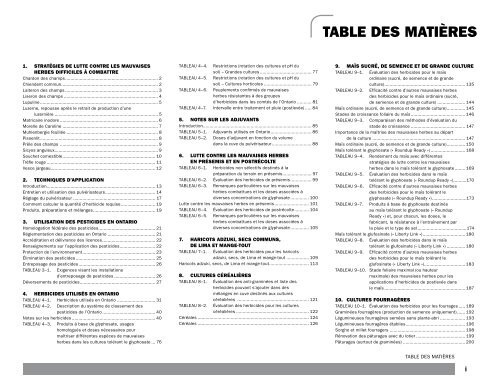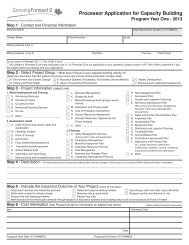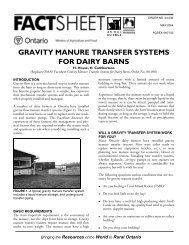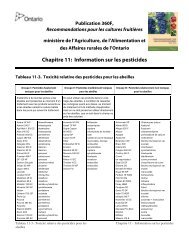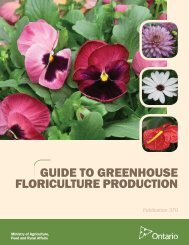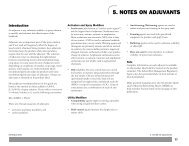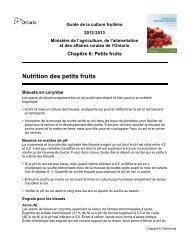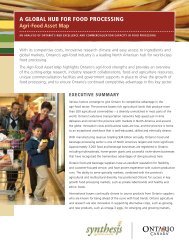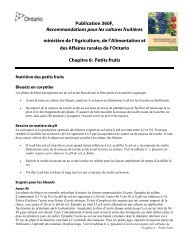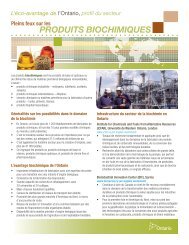Guide de lutte contre les mauvaises herbes 2012â2013
Guide de lutte contre les mauvaises herbes 2012â2013
Guide de lutte contre les mauvaises herbes 2012â2013
You also want an ePaper? Increase the reach of your titles
YUMPU automatically turns print PDFs into web optimized ePapers that Google loves.
TABLE DES MATIÈRES<br />
1. STRATÉGIES DE LUTTE CONTRE LES MAUVAISES<br />
HERBES DIFFICILES À COMBATTRE<br />
Chardon <strong>de</strong>s champs....................................................................... 2<br />
Chien<strong>de</strong>nt commun.......................................................................... 2<br />
Laiteron <strong>de</strong>s champs....................................................................... 3<br />
Liseron <strong>de</strong>s champs........................................................................ 4<br />
Lupuline.......................................................................................... 5<br />
Luzerne, repousse après le retrait <strong>de</strong> production d’une<br />
luzernière............................................................................... 5<br />
Matricaire inodore........................................................................... 6<br />
Morelle <strong>de</strong> Caroline......................................................................... 7<br />
Muhlenbergie feuillée...................................................................... 8<br />
Pissenlit.......................................................................................... 8<br />
Prêle <strong>de</strong>s champs ........................................................................... 9<br />
Sicyos anguleux............................................................................... 9<br />
Souchet comestible....................................................................... 10<br />
Trèfle rouge................................................................................... 11<br />
Vesce jargeau................................................................................ 12<br />
2. TECHNIQUES D’APPLICATION<br />
Introduction.................................................................................. 13<br />
Entretien et utilisation <strong>de</strong>s pulvérisateurs...................................... 14<br />
Réglage du pulvérisateur............................................................... 17<br />
Comment calculer la quantité d’herbici<strong>de</strong> requise........................... 19<br />
Produits, préparations et mélanges................................................ 19<br />
3. UTILISATION DES PESTICIDES EN ONTARIO<br />
Homologation fédérale <strong>de</strong>s pestici<strong>de</strong>s............................................ 21<br />
Réglementation <strong>de</strong>s pestici<strong>de</strong>s en Ontario..................................... 21<br />
Accréditation et délivrance <strong>de</strong>s licences......................................... 22<br />
Renseignements sur l’application <strong>de</strong>s pestici<strong>de</strong>s............................ 22<br />
Protection <strong>de</strong> l’environnement........................................................ 23<br />
Élimination <strong>de</strong>s pestici<strong>de</strong>s............................................................. 25<br />
Entreposage <strong>de</strong>s pestici<strong>de</strong>s........................................................... 26<br />
TABLEAU 3–1. Exigences visant <strong>les</strong> installations<br />
d’entreposage <strong>de</strong> pestici<strong>de</strong>s................................ 26<br />
Déversements <strong>de</strong> pestici<strong>de</strong>s.......................................................... 27<br />
4. HERBICIDES UTILISÉS EN ONTARIO<br />
TABLEAU 4–1. Herbici<strong>de</strong>s utilisés en Ontario.............................. 31<br />
TABLEAU 4–2. Description du système <strong>de</strong> classement <strong>de</strong>s<br />
pestici<strong>de</strong>s <strong>de</strong> l’Ontario......................................... 40<br />
Notes sur <strong>les</strong> herbici<strong>de</strong>s................................................................ 40<br />
TABLEAU 4–3. Produits à base <strong>de</strong> glyphosate, usages<br />
homologués et doses nécessaires pour<br />
maîtriser différentes espèces <strong>de</strong> <strong>mauvaises</strong><br />
<strong>herbes</strong> dans <strong>les</strong> cultures tolérant le glyphosate.... 76<br />
TABLEAU 4–4. Restrictions (rotation <strong>de</strong>s cultures et pH du<br />
sol) – Gran<strong>de</strong>s cultures........................................ 77<br />
TABLEAU 4–5. Restrictions (rotation <strong>de</strong>s cultures et pH du<br />
sol) – Cultures hortico<strong>les</strong>..................................... 79<br />
TABLEAU 4–6. Peuplements confirmés <strong>de</strong> <strong>mauvaises</strong><br />
<strong>herbes</strong> résistantes à <strong>de</strong>s groupes<br />
d’herbici<strong>de</strong>s dans <strong>les</strong> comtés <strong>de</strong> l’Ontario............ 81<br />
TABLEAU 4–7. Intervalle entre traitement et pluie (postlevée)...... 84<br />
5. NOTES SUR LES ADJUVANTS<br />
Introduction.................................................................................. 85<br />
TABLEAU 5–1. Adjuvants utilisés en Ontario................................ 86<br />
TABLEAU 5–2. Doses d’adjuvant en fonction du volume<br />
dans la cuve du pulvérisateur............................... 88<br />
6. LUTTE CONTRE LES MAUVAISES HERBES<br />
EN PRÉSEMIS ET EN POSTRÉCOLTE<br />
TABLEAU 6–1. Herbici<strong>de</strong>s non sélectifs <strong>de</strong>stinés à la<br />
préparation du terrain en présemis....................... 97<br />
TABLEAU 6–2. Évaluation <strong>de</strong>s herbici<strong>de</strong>s <strong>de</strong> présemis................. 99<br />
TABLEAU 6–3. Remarques particulières sur <strong>les</strong> <strong>mauvaises</strong><br />
<strong>herbes</strong> combattues et <strong>les</strong> doses associées à<br />
diverses concentrations <strong>de</strong> glyphosate............... 100<br />
Lutte <strong>contre</strong> <strong>les</strong> <strong>mauvaises</strong> <strong>herbes</strong> en présemis........................... 101<br />
TABLEAU 6–4. Évaluation <strong>de</strong>s herbici<strong>de</strong>s <strong>de</strong> postrécolte............ 104<br />
TABLEAU 6–5. Remarques particulières sur <strong>les</strong> <strong>mauvaises</strong><br />
<strong>herbes</strong> combattues et <strong>les</strong> doses associées à<br />
diverses concentrations <strong>de</strong> glyphosate............... 105<br />
7. HARICOTS ADZUKI, SECS COMMUNS,<br />
DE LIMA ET MANGE‐TOUT<br />
TABLEAU 7–1. Évaluation <strong>de</strong>s herbici<strong>de</strong>s pour <strong>les</strong> haricots<br />
adzuki, secs, <strong>de</strong> Lima et mange-tout.................. 109<br />
Haricots adzuki, secs, <strong>de</strong> Lima et mange-tout............................... 113<br />
8. CULTURES CÉRÉALIÈRES<br />
TABLEAU 8–1. Évaluation <strong>de</strong>s anti-graminées et liste <strong>de</strong>s<br />
herbici<strong>de</strong>s pouvant s’ajouter dans <strong>de</strong>s<br />
mélanges en cuve <strong>de</strong>stinés aux cultures<br />
céréalières ....................................................... 121<br />
TABLEAU 8–2. Évaluation <strong>de</strong>s herbici<strong>de</strong>s pour <strong>les</strong> cultures<br />
céréalières........................................................ 122<br />
Céréa<strong>les</strong>..................................................................................... 124<br />
Céréa<strong>les</strong>..................................................................................... 126<br />
9. MAÏS SUCRÉ, DE SEMENCE ET DE GRANDE CULTURE<br />
TABLEAU 9–1. Évaluation <strong>de</strong>s herbici<strong>de</strong>s pour le maïs<br />
ordinaire (sucré, <strong>de</strong> semence et <strong>de</strong> gran<strong>de</strong><br />
culture).............................................................. 135<br />
TABLEAU 9–2. Efficacité <strong>contre</strong> d’autres <strong>mauvaises</strong> <strong>herbes</strong><br />
<strong>de</strong>s herbici<strong>de</strong>s pour le maïs ordinaire (sucré,<br />
<strong>de</strong> semence et <strong>de</strong> gran<strong>de</strong> culture)...................... 144<br />
Maïs ordinaire (sucré, <strong>de</strong> semence et <strong>de</strong> gran<strong>de</strong> culture)............... 145<br />
Sta<strong>de</strong>s <strong>de</strong> croissance foliaire du maïs.......................................... 146<br />
TABLEAU 9–3. Comparaison <strong>de</strong>s métho<strong>de</strong>s d’évaluation du<br />
sta<strong>de</strong> <strong>de</strong> croissance.......................................... 147<br />
Importance <strong>de</strong> la maîtrise <strong>de</strong>s <strong>mauvaises</strong> <strong>herbes</strong> au départ<br />
<strong>de</strong> la culture....................................................................... 147<br />
Maïs ordinaire (sucré, <strong>de</strong> semence et <strong>de</strong> gran<strong>de</strong> culture)............... 150<br />
Maïs tolérant le glyphosate (« Roundup Ready »)........................... 168<br />
TABLEAU 9–4. Ren<strong>de</strong>ment du maïs avec différentes<br />
stratégies <strong>de</strong> <strong>lutte</strong> <strong>contre</strong> <strong>les</strong> <strong>mauvaises</strong><br />
<strong>herbes</strong> dans le maïs tolérant le glyphosate......... 169<br />
TABLEAU 9–5. Évaluation <strong>de</strong>s herbici<strong>de</strong>s dans le maïs<br />
tolérant le glyphosate (« Roundup Ready »)...........170<br />
TABLEAU 9–6. Efficacité <strong>contre</strong> d’autres <strong>mauvaises</strong> <strong>herbes</strong><br />
<strong>de</strong>s herbici<strong>de</strong>s pour le maïs tolérant le<br />
glyphosate (« Roundup Ready »)...........................173<br />
TABLEAU 9–7. Produits à base <strong>de</strong> glyphosate <strong>de</strong>stinés<br />
au maïs tolérant le glyphosate (« Roundup<br />
Ready ») et, pour chacun, <strong>les</strong> doses, le<br />
fabricant, la résistance à l’entraînement par<br />
la pluie et le type <strong>de</strong> sel......................................174<br />
Maïs tolérant le glufosinate (« Liberty Link »)................................. 180<br />
TABLEAU 9–8. Évaluation <strong>de</strong>s herbici<strong>de</strong>s dans le maïs<br />
tolérant le glufosinate (« Liberty Link »)............... 180<br />
TABLEAU 9–9. Efficacité <strong>contre</strong> d’autres <strong>mauvaises</strong> <strong>herbes</strong><br />
<strong>de</strong>s herbici<strong>de</strong>s pour le maïs tolérant le<br />
glufosinate (« Liberty Link »)................................ 183<br />
TABLEAU 9–10. Sta<strong>de</strong> foliaire maximal (ou hauteur<br />
maximale) <strong>de</strong>s <strong>mauvaises</strong> <strong>herbes</strong> pour <strong>les</strong><br />
applications d’herbici<strong>de</strong>s <strong>de</strong> postlevée dans<br />
le maïs.............................................................. 187<br />
10. CULTURES FOURRAGÈRES<br />
TABLEAU 10–1. Évaluation <strong>de</strong>s herbici<strong>de</strong>s pour <strong>les</strong> fourrages...... 189<br />
Graminées fourragères (production <strong>de</strong> semence uniquement)....... 192<br />
Légumineuses fourragères semées sans plante-abri.................... 193<br />
Légumineuses fourragères établies.............................................. 196<br />
Sorgho et millet fourragers.......................................................... 198<br />
Rénovation <strong>de</strong>s pâturages avec du lotier...................................... 199<br />
Pâturages (surtout <strong>de</strong> graminées)................................................ 200<br />
TABLE DES MATIÈRES<br />
i


